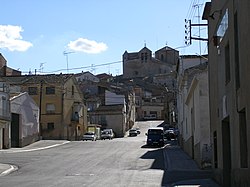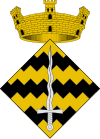
Morocco spans from the Mediterranean Sea and Atlantic Ocean on the north and the west respectively, into large mountainous areas in the interior, to the Sahara desert in the far south. Morocco is a Northern African country, located in the extreme northwest of Africa on the edge of continental Europe. The Strait of Gibraltar separates Spain from Morocco with a 13 kilometres (8.1 mi) span of water. Morocco borders the North Atlantic Ocean to the west, and the western Mediterranean Sea to the north.

In geography, the temperate climates of Earth occur in the middle latitudes, which span between the tropics and the polar regions of Earth. These zones generally have wider temperature ranges throughout the year and more distinct seasonal changes compared to tropical climates, where such variations are often small.

Tortosa is the capital of the comarca of Baix Ebre, in Catalonia, Spain.

The Köppen climate classification is one of the most widely used climate classification systems. It was first published by German-Russian climatologist Wladimir Köppen (1846–1940) in 1884, with several later modifications by Köppen, notably in 1918 and 1936. Later, the climatologist Rudolf Geiger (1894-1981) introduced some changes to the classification system, which is thus sometimes called the Köppen–Geiger climate classification system.

An oceanic climate, also known as a maritime climate, marine climate is the Köppen classification of climate typical of west coasts in higher middle latitudes of continents, and generally features mild summers and cool but not cold winters, with a relatively narrow annual temperature range and few extremes of temperature. Oceanic climate is found both in the temperate and subtropical areas, In Western Europe, parts of central and Southern Africa, North America as well as part of Australia and New Zealand.

A humid continental climate is a climatic region defined by Russo-German climatologist Wladimir Köppen in 1900, typified by four distinct seasons and large seasonal temperature differences, with warm to hot summers and cold winters. Precipitation is usually distributed throughout the year. The definition of this climate regarding temperature is as follows: the mean temperature of the coldest month must be below −3 °C (26.6 °F) and there must be at least four months whose mean temperatures are at or above 10 °C (50 °F). In addition, the location in question must not be semi-arid or arid. The Dfb, Dwb and Dsb subtypes are also known as hemiboreal.

Manlleu is municipality in the comarca of Osona, in the province of Barcelona, Catalonia, northern Spain.
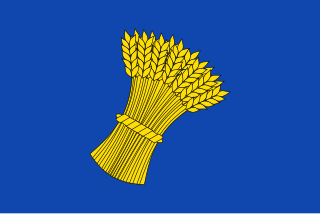
Canjáyar is an agricultural town in Almería province, in the autonomous community of Andalusia, Spain. It is situated along the river Andarax in the Alpujarra region of Almería 47 kilometers from the provincial capital, Almería. The mild climate in Canjáyar makes it a year-round tourist destination. Canjáyar is found at the foot of Sierra Nevada, looking over into the Sierra de Gádor. Surrounded by orchards, which are themselves served by a system of hundred year old aqueducts, it is a great place to enjoy rural tourism.

The woodlands of the Iberian Peninsula are distinct ecosystems on the Iberian Peninsula. Although the various regions are each characterized by distinct vegetation, the borders between these regions are not clearly defined, and there are some similarities across the peninsula.

Costers del Segre is a Spanish Denominación de Origen Protegida (DOP) for wines located in the province of Lleida and is divided into several separate sub-zones. The four original subzones created in 1988 are Artesa, to the northeast of Lleida, Valls de Riucorb to the east, Garrigues and Raïmat. In 1998 two other subzones were added: Pallars Jussà, next to the town of Tremp, 90 km north of Lleida and Segrià to the west and surrounded by the Raimat subzone.

Cabrils is a city and municipality in the comarca of Maresme in the province of Barcelona and autonomous community of Catalonia, Spain. It is situated between the municipalities of Vilassar de Mar, Vilassar de Dalt, Òrrius, Argentona and Cabrera de Mar, about ten kilometres from Mataró, the comarca capital.
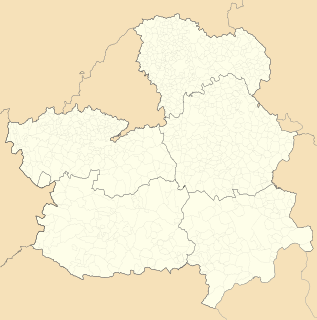
Villarejo de Fuentes is a municipality located in the province of Cuenca, Castile-La Mancha, Spain. According to the 2015 census (INE), the municipality has a population of 519 inhabitants.

The climate of Romania is temperate continental transitioning into an oceanic climate on the eastern coast, influenced by Scandinavian-Baltic weather, the Mediterranean and the Black Sea. Thus, in the south, there are some influences of a mediterranean climate, characterized by mild winters and stronger rainfalls in the cooler months. In the south-east, the Black Sea induces rare heavy strong rains. In eastern regions the continental character is less pronounced. In the north of the country, the effect of the Scandinavian-Baltic climate is felt, effecting a wetter and colder climate with cold winters. The west of the country has a more pronounced influence of low pressure systems generated over the Atlantic, causing moderate temperatures and stronger precipitation. Climate nuances are demonstrated on the steps of the altitude, the mountain ranges of the Carpathian arc have a cool mountain climate with high humidity throughout the year.
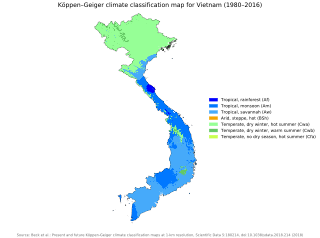
Located in both a temprate and a tropical zone, Vietnam's climate is characterized by strong monsoon influences but has a considerable amount of sun, a high rate of rainfall, and high humidity. The diverse topography, long latitude, and influences from the South China Sea lead to climatic conditions varying significantly between regions. In the north, the climate is monsoonal with four distinct seasons while in the south, the climate is tropical monsoon with two seasons. In addition, a temperate climate exists in mountainous areas, which are found in Sa Pa and Da Lat, while a more continental climate exists in Lai Châu Province and Sơn La Province.
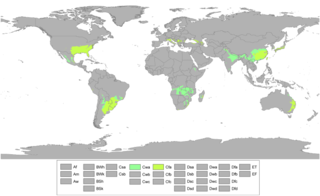
A humid subtropical climate is a zone of climate characterized by hot and humid summers, and cold to mild winters. These climates normally lie on the southeast side of all continents, generally between latitudes 25° and 40° and are located poleward from adjacent tropical climates. It is also known as warm temperate climate.

Carme is a municipality in the comarca of the Anoia in Catalonia, Spain. The town is in the middle of a valley, which is surrounded by the Orpinell range and the other by the Collbàs range. The village is at the bottom of the valley and is surrounded by forests. The capital of the region of Anoia, Igualada, is just ten kilometers from the village, while other municipalities like La Pobla de Claramunt or Capellades are about five kilometers from the village. Currently the village has approximately 800 inhabitants, but in holiday seasons this figure may be slightly increased.

Rubió is a rural municipality in the comarca of Anoia in Catalonia, Spain. Its administrative centre is the village of Rubió, and other villages include Maçana and El Pla de Rubió. As of 2014, the municipality had 228 inhabitants. At 48 square kilometres (19 sq mi) it is one of the largest municipalities of the Alta Segarra, and at one time was the most sparsely populated.

The climate in Spain varies across continental Spain. Spain is the most climatically diverse country in Europe with 13 different Köppen climates, excluding the Canary Islands, and is within the 10 most climatically diverse countries in the world. Five main climatic zones can be distinguished, according to the country's Köppen-Geiger climate classification and orographic conditions:

Almoster is a village in the province of Tarragona and autonomous community of Catalonia, Spain. According to the 2008 census, its population was of 1,339 inhabitants.

The Northeastern Spain and Southern France Mediterranean forests is a Mediterranean forests, woodlands, and scrub ecoregion in southwestern Europe. It occupies the Mediterranean coastal region of northeastern Spain and Southern France, and the Balearic Islands.
